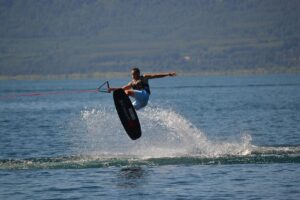It’s a lot of fun to buy wakeboarding gear, especially if you’re just getting started. However, it may be somewhat daunting and difficult to know what you need to stay safe while also being comfy and able to move freely when out on the water.
It’s always a good idea to seem a little bit cool on the board. Still, appearance isn’t everything. It’s preferable to be practical in the beginning and move on to more advanced wakeboarding gear and equipment when you’re confident that you’ll continue to wakeboard and practice it regularly.
We recommend renting your own board because you won’t know who has used it previously and how it’s kept.
Here are a few ideas for what you could get to enhance your wakeboarding experiences. These are the bare necessities, and while it may not appear like you need much, if you have these items, you’ll be ready to perform flips and tricks in no time!
Get Yourself A Wetsuit
Wetsuits are an important piece of equipment for wakeboarders, including novices, and they’re worn by everyone from beginners to experts.
There are numerous different wetsuits available for you to purchase, including sleeveless, short-sleeved, short-legged, long-sleeved, and various thicknesses.
The majority of winter wetsuits are 4mm to 5mm thick, while summer wetsuits are generally between 2mm and 3mm thick. The thickness measurements represent the thickness of the Neoprene wetsuit fabric that will cover your body. It works by trapping a layer of water between your skin and the material.
The water between your fingers is about 20 degrees Fahrenheit. When you’re out on the lake for hours, your hands will rapidly grow cold and numb in order to maintain proper body temperature. Neoprene gloves can also be used by winter wakeboarders to keep their hands dry and warm.
There are wetsuits with shortened legs and arms for warmer conditions. During your first wakeboarding lesson, your instructor will advise you on which wetsuit to use.
Make Sure You Get A Buoyancy AID
It’s also a good idea to wear a life jacket or buoyancy aid like as with other water sports. They’re required of all wakeboarders, and if you plan on visiting a wakeboarding facility, they’ll almost certainly be necessary.
A buoyancy aid will keep you afloat while in the water, allowing you to float up to the top if you fall off your wakeboard, reducing the chance of being trapped beneath a wave of backwash. Buoyancy aids may help you stay above the water with very little effort while you wait for the boat to arrive and pick you up.
Your buoyancy aid would be there to keep you afloat if you fall off your board and are unable to do so yourself, as it is with any other type of life jacket. It’s a must-have item that shouldn’t be overlooked because it’s uncool, unfashionable, or needless.
If you’re a novice, go for a normal buoyancy aid. Advanced wakeboarders will want to use an impact vest instead. Impact vests aren’t as buoyant as standard aids; nevertheless, they do offer more protection for the border, especially those riding at higher speeds and performing lots of spins and flips.
They offer more protection when they’re training on or around water or other obstacles.
Invest In Good Headgear
Helmets are likewise a necessary component of wakeboarders’ safety equipment, much like life jackets. Whether you’re a novice or an advanced wakeboarder, wearing a helmet is essential to avoid injury from falling into the water.
When travelling at high speeds, there’s a greater chance that you’ll lose your grip and fall off your board, crashing into the water or colliding with obstructions that you’ve been training on and around.
It’s important to protect your head while riding a high-speed bike in the same way. It would be great if you got used to wearing a helmet when on the water so that it became second nature for you to wear one when participating in the sport.
Wakeboarding helmets are designed specifically for water sports and are therefore always preferable to wearing your regular cycling helmet!
Although they have very similar features, cycling and swimming helmets differ significantly in terms of design, construction, and weight. Cycling helmets are heavier and bulkier than typical sports headgear, while water sporting helmets are lighter and provide some buoyancy to help the wearer float in the water rather than weighing their head down.
A watersports helmet will allow the water to flow through and out, preventing your head from becoming clogged with water if it goes under the water.
Buy a Wakeboard
Choosing the proper wakeboard is an important aspect of participating in the activity. There’s a lot more to it than picking the one with the coolest designs and images.
When purchasing a wakeboard, there are several factors to consider:
- What size to go for
- Should it be single
- What graphics do you want on your board
- How heavy should your board be
- Do you need wakeboarding boots
For those who are new to the sport, we propose beginning with a lower-priced board or one of our beginning wakeboards just in case you aren’t completely committed to it after your first few attempts, at least you won’t have wasted money on a professional board!
Wakeboarding Boots
Wakeboarding boots are also known as wakeboard bindings. They attach your feet to the board so you can stay on for longer when towed.
There are numerous sorts of bindings to select from, some of which are basic and others of which have detachable boots that you may walk around in while wearing.
Comfort is one of the most important factors to think about when purchasing wakeboarding boots, especially since it’s what makes the most difference while having a good ride.
